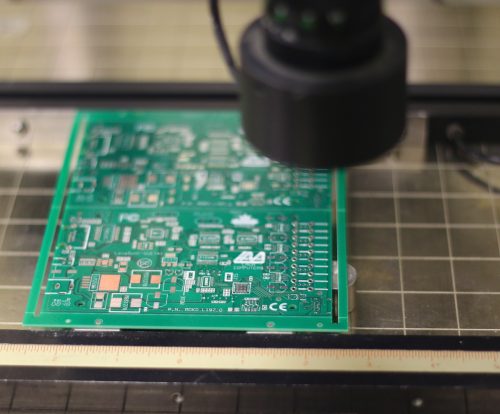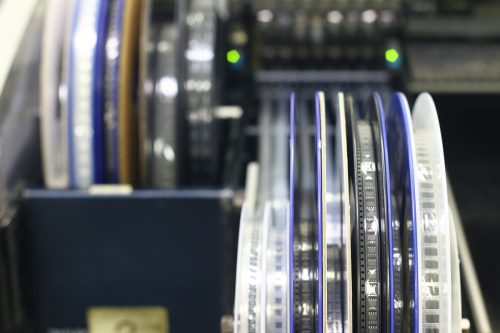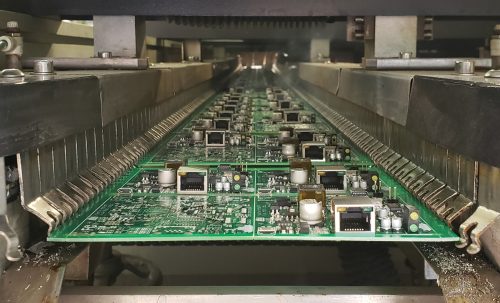How We Manufacture and Innovate Our Products
6 Min Read
May 26, 2023
At LAVA, we design and manufacture all our products in-house. We have roughly 26,000 square feet of space in our Toronto headquarters, which houses both our factory and our sales office. Despite being a small team of engineers, production and sales/marketing staff, we can fulfill most orders in 1-2 weeks.
Today our core business is SimulCharge adapters, which provide mobile devices with simultaneous power and data. Of these devices, Power over Ethernet (PoE) and Ethernet adapters are our most-popular sellers.
Our SimulCharge technology dates back to 2014. To this day, we are the only company that found a reliable way to allow a Micro USB mobile device to access USB peripherals while charging it. In the USB-C space, we have some competition. However, we have developed unique technologies, such as Battery Modulation and True Dead Battery Mode, that put us ahead of the pack.
While our products have changed over the years, our standards haven’t.
How we design our products
It all starts with the design. When we build a new product, we first design it on paper, laying out all initial specifications and circuit designs by hand. Once we are happy with the initial concept, we go digital. For PCBs, we use Altium Designer, which is an electronic design automation software. With Altium Designer, we design the layout of the board before it goes into production. For mechanical parts, we use SolidWorks, a computer-aided design (CAD) program for solid modelling.
In addition to these programs, we also use an Ultimaker S5 3D printer for prototyping and building some production jigs and parts when needed. We generally use 3D printing for prototypes of our adapter casings. (The final casings are created through an injection moulding process.) The 3D prototyping step allows us to ensure the casing’s holes for the ports and LEDs on the PCB line up properly before we send the designs off for manufacture.
Building a product prototype
When building a new product, we first build a prototype. We do this because manufacturing a prototype is the most effective and cost-efficient way to bring an engineering design out of theory and into the real world for testing.
The process of building a prototype for a new product is broken down into four major stages:
1. The first stage is idea generation. If we are building the product for a customer that needs a specific problem resolved, we brainstorm methods to solve it.
2. Once we have developed a theoretical solution for the customer’s problem, we enter the second stage where we manufacture the prototype. Once we produce an initial prototype, we determine which features work well, which need improvement, and re-evaluate our design with each passing discovery.
3. In the third stage, we send the prototype to the customer to get feedback and make adjustments to the prototype. The prototype may be sent back and forth multiple times with modifications made each time to ensure it works as desired.
4. The fourth and final stage is beginning the manufacturing process, which we will explain in greater detail below.
For more on why we build prototypes, check out this article.
Building the products
Once we have the design and have successfully prototyped the product, we move onto production. While we design our PCBs in-house, they are physically manufactured by S&P Flex Inc. whose plant is less than an hour’s drive away from LAVA’s office.
The steps for building our mobile adapters are as follows:
Reflow soldering
 Step 1. The unpopulated PCBs arrive at our facility from S&P Flex Inc., with our layouts already imprinted on them. These serve as blueprints for our soldering machines. At LAVA, we use two types of soldering methods to secure components onto the PCBs: reflow and wave.
Step 1. The unpopulated PCBs arrive at our facility from S&P Flex Inc., with our layouts already imprinted on them. These serve as blueprints for our soldering machines. At LAVA, we use two types of soldering methods to secure components onto the PCBs: reflow and wave.
Step 2. We insert the PCBs in the solder paste printer and cover it with a solder screen, featuring the same blueprint as the PCBs’ copper-clad laminate bases with cutouts that match where the components are to be attached. The solder paste (a mixture of flux and powdered solder) is wiped across the solder screen, filling the cutouts and acting as glue for the components.
 Step 3. To precisely mount the components to the PCBs, we use a Mydata SMT (pick-and-place) machine that places the surface-mount components (i.e. electronic components) onto the PCB.
Step 3. To precisely mount the components to the PCBs, we use a Mydata SMT (pick-and-place) machine that places the surface-mount components (i.e. electronic components) onto the PCB.
Step 4. After the components are mounted, we bake the PCBs in the solder oven to ensure the paste has melted and cooled properly, and the components are securely attached. Click here for visual guides of the reflow soldering process.
Wave soldering
 Step 5. The PCBs go through our wave soldering machine for through-hole technology (THT) joining. Instead of being soldered on top, some components (such as pins) pass through small holes in the boards on both sides of the PCB.
Step 5. The PCBs go through our wave soldering machine for through-hole technology (THT) joining. Instead of being soldered on top, some components (such as pins) pass through small holes in the boards on both sides of the PCB.
We manually insert these components into the small holes on each PCB and then the wave soldering machine solders the connections. The machine sprays the PCBs with a flux to reduce the surface tension and eliminate oxides, allowing for more reliable joints.
The boards move on a conveyor belt through a molten solder wave, which covers the bottom of the PCBs to secure each THT component’s position and ensure every pin is covered with a layer of solder. The boards are then washed and left to dry. Click here for visual guides of the wave soldering process.
Testing the boards and getting them ready for delivery
Step 6. Once the boards are built, we test each one to make sure they work properly. Our failure rate is well below 1%. We often have production runs where we don’t find a single faulty unit. Usually, with a statistical sample test system, the end customer still gets a failed unit 1-2% of the time. By testing every single PCB, we catch those defective units before we send them out.
 If we do come across a defective board, we try to repair it. Our engineers sit near the manufacturing area and can offer their expertise quickly if a larger problem comes up during the manufacturing process. This opportunity to quickly address issues can also lead to further innovation and less production loss. The engineers have front-row seats to seeing their concepts and ideas come to life, allowing them to fine-tune their designs quickly and avoid repeat inconveniences in the future.
If we do come across a defective board, we try to repair it. Our engineers sit near the manufacturing area and can offer their expertise quickly if a larger problem comes up during the manufacturing process. This opportunity to quickly address issues can also lead to further innovation and less production loss. The engineers have front-row seats to seeing their concepts and ideas come to life, allowing them to fine-tune their designs quickly and avoid repeat inconveniences in the future.
Step 7. When we have tested our board and confirmed it works, we then put it inside the casing, screw it together and affix the label. We design and print all our labels in-house as well.
Order management
 At LAVA, we use a combination of Just-in-Time (JIT) and batch production to fulfill our orders. JIT involves receiving only the materials required for currently placed orders, utilizing the resources on hand with maximum efficiency and eliminating unnecessary inventory storage and costs. Batch production means we organize and produce the units in batches or groups.
At LAVA, we use a combination of Just-in-Time (JIT) and batch production to fulfill our orders. JIT involves receiving only the materials required for currently placed orders, utilizing the resources on hand with maximum efficiency and eliminating unnecessary inventory storage and costs. Batch production means we organize and produce the units in batches or groups.
When we have a large order for a particular adapter, we might choose to manufacture additional units for our inventory. This ensures we will have enough of our commercial off-the-shelf adapters in stock for small orders but prevents us from having too much overstock.
We also design our PCBs so they can be used for multiple products. In other words, we don’t have a different PCB for every adapter. Many of our adapters use the same-size PCB and can use the same casings. It’s the components that vary from adapter to adapter. As a result, we have less supply management issues.
Proudly Canadian
Just as our SimulCharge adapters were created to allow a Samsung tablet to be used as a loyalty rewards system, Battery Modulation was invented to solve a problem with battery bloating in permanent tablet installations.
We are constantly inventing new products and improving existing ones, both in the design stage and during production. We design and assemble our products in-house, and use Canadian suppliers as much as we can. We’re proud to manufacture in Canada and strive to make sure we deliver the best product to the customer.
If you want to know more about our SimulCharge products check out the website or reach out to sales by email at sales@lavalink.com or by phone at 1-416-674-5942.
Subscribe to LAVA’s Newsletter and stay up to date on the latest company news, new product releases, and tech industry insights.
